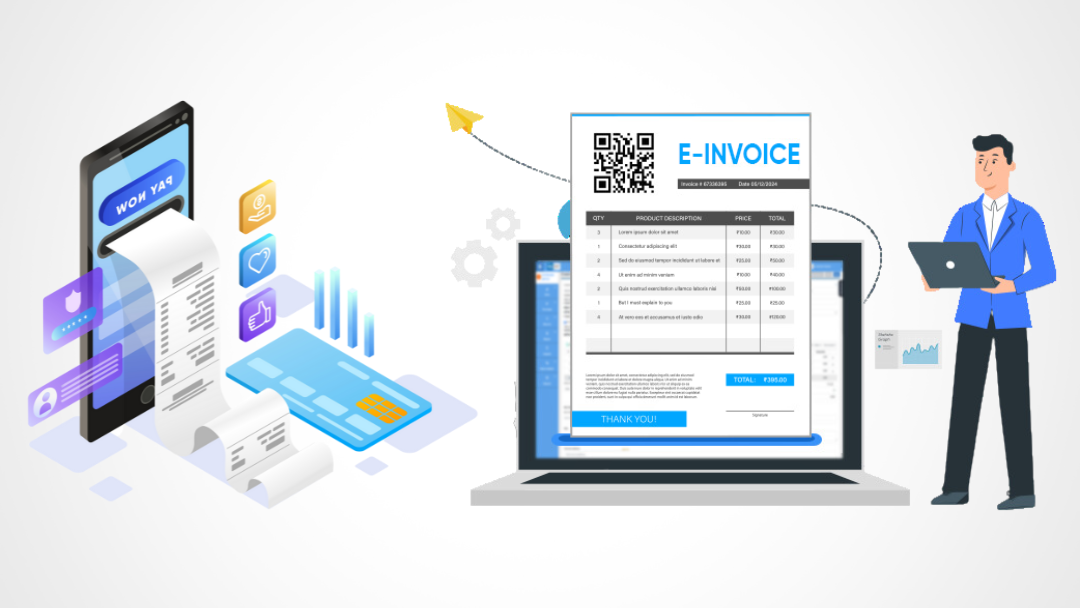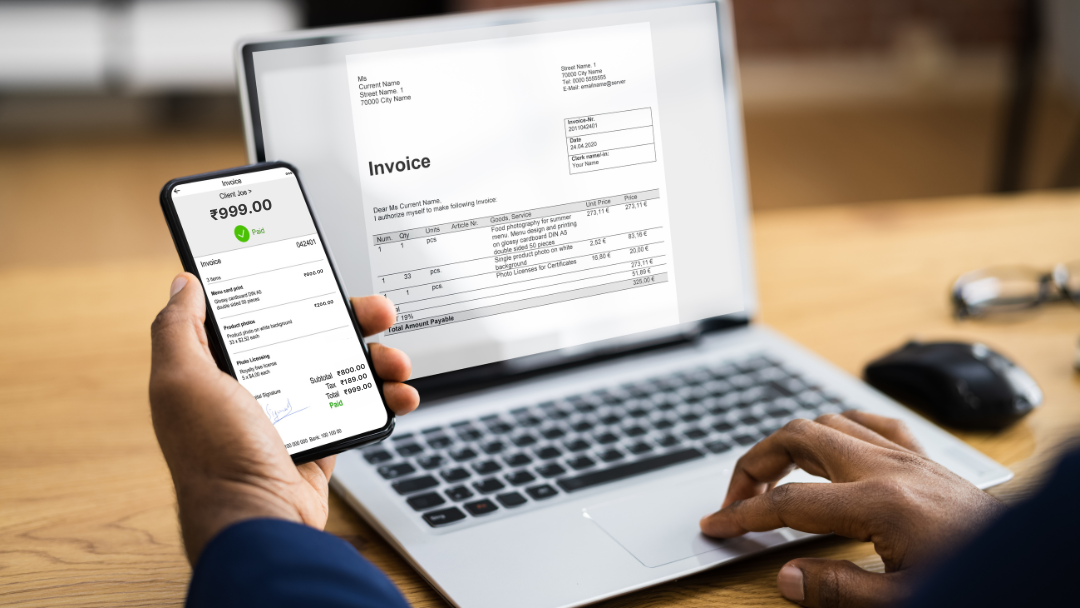WHAT IS E-INVOICING?
E-invoicing, also known as electronic invoicing or electronic billing, is the process of sending and receiving invoices electronically, rather than using traditional paper-based methods. It involves the exchange of invoice data between a supplier and a buyer through electronic means, such as email, electronic data interchange (EDI), or web-based portals.
E-invoicing aims to streamline and automate the invoicing process, to improve efficiency, reduce errors, and cut costs. It eliminates the need for manual data entry and paper-based documentation, making it faster and more accurate. It also simplifies invoice management, as invoices can be electronically stored, indexed, and retrieved when needed.

E-invoicing typically includes structured invoice data, including invoice details, item descriptions, quantities, prices, taxes, and payment terms. It may also include digital signatures or other security features to ensure the authenticity and integrity of the invoice.
Some advantages of e-invoicing include faster invoice processing, reduced administrative costs, improved data accuracy, enhanced payment visibility and control, and better supplier-buyer relationships. It is often used in business-to-business (B2B) transactions but can also be applied to business-to-consumer (B2C) scenarios.
E-invoicing is increasingly mandated or encouraged by governments worldwide as part of their digital transformation initiatives, aiming to promote automation, simplify tax compliance, and reduce fraud.
What are the benefits of E-Invoicing for businesses?
1. Cost Savings:
E-invoicing eliminates the need for paper, printing, and postage costs associated with traditional paper-based invoices. Additionally, it reduces the need for manual data entry, reducing labor costs.
2. Time-Saving:
With e-invoicing, invoices can be sent and received instantly, reducing the time it takes for the payment process. This results in quick payments resulting in improved cash flow for businesses.
3. Improved Accuracy:
E-invoicing minimizes the chances of errors caused by manual data entry. Electronic invoices are generated automatically, reducing the risk of human mistakes and ensuring accuracy in billing.
4. Enhanced Security:
Digital invoices are more secure than paper invoices that can be easily lost or stolen. E-invoicing systems often use encryption and secure protocols to protect invoicing data.
5. Improved Supplier Relationships:
Efficient payment processes and faster payment cycles through e-invoicing can lead to stronger relationships with suppliers. Prompt payments can improve the overall relationship and result in preferential treatment from suppliers.
6. Better Visibility and Control:
E-invoicing provides businesses with real-time access to financial data, allowing them to track and monitor invoices, payments, and cash flow more effectively. This supports financial planning and apt decision-making.
7. Eco-Friendly:
By eliminating the need for paper, e-invoicing reduces paper wastage and environmental impact. This aligns with sustainability goals and promotes environmental responsibility.
8. Integration with Other Systems:
E-invoicing systems can be integrated with other business software, such as accounting systems and payment platforms, streamlining the entire invoicing and payment process.
9. Compliance with Regulations:
Many countries have implemented regulations requiring businesses to use electronic invoicing. Utilizing e-invoicing ensures compliance with these regulations and avoids potential penalties.
Overall, e-invoicing offers numerous benefits, including cost savings, time efficiency, accuracy, security, sustainability, improved visibility, and stronger supplier relationships.
Applicability of e-invoing under GST
E-invoicing is applicable under the Goods and Services Tax (GST) system in India. The government introduced e-invoicing to simplify the invoicing process, reduce errors, and increase transparency in tax compliance.
The applicability of e-invoicing under GST is determined based on the aggregate turnover of a business. Initially, e-invoicing was mandatory for businesses with an aggregate turnover exceeding INR 100 crore in any financial year from 2017-18 onwards. However, the limit was reduced to INR 50 crore from 2021-22 onwards.
E-invoicing is applicable to businesses engaged in the supply of goods or services that are registered under GST. It is not applicable to individuals or businesses exempt from GST registration.
Under e-invoicing, businesses must generate and submit their invoices electronically in a specified format to the Invoice Registration Portal (IRP) before issuing them to the recipients. The IRP validates the invoice and generates a unique Invoice Reference Number (IRN) and a Quick Response (QR) code for each invoice.
This electronic validation process ensures the authenticity and integrity of the invoices, making it easier for tax authorities to verify and reconcile the invoices automatically, reducing errors and discrepancies.
Overall, e-invoicing under GST aims to streamline the invoicing process, improve compliance, and facilitate the efficient tracking and reconciliation of invoices, benefiting both businesses and tax authorities.
Summing Up: How to generate an e-ivoice under GST?
To generate an e-invoice under GST (Goods and Services Tax) in India, you need to follow these steps:
Ensure you have the necessary data: Collect all the required information for generating an e-invoice, such as your GSTIN (Goods and Services Tax Identification Number), the receiver’s GSTIN, invoice number, invoice date, description of goods or services, quantity, unit price, applicable tax rates, etc.
Choose the e-invoice generation method: There are multiple ways to generate an e-invoice under GST. You can either use the GST portal (www.gst.gov.in), or you can use an API-based solution provided by a GST Suvidha Provider (GSP) or an Application Service Provider (ASP). Alternatively, you can also use an offline utility tool provided by the GSTN (GST Network).
Authenticate yourself: Log in to the GST portal using your login credentials or authenticate yourself through the chosen API-based solution or offline utility tool.
Prepare the e-invoice: Enter all the required details mentioned in step 1 into the e-invoice generation platform.
Validate the e-invoice: Validate the entered details for accuracy and ensure that they comply with the GST rules and regulations.
Generate the e-invoice: After validation, click on the “Generate e-Invoice” button to generate the e-invoice document.
Verify the generated e-invoice: Review the generated e-invoice to confirm that all details are correct, including the unique Invoice Reference Number (IRN) and the QR code.
Sign and send the e-invoice: Sign the e-invoice digitally using a Digital Signature Certificate (DSC) or an Electronic Verification Code (EVC). Finally, send the e-invoice to the recipient via email or any other agreed-upon electronic method.
Report the e-invoice to the Invoice Registration Portal (IRP): Upload the signed e-invoice to the designated IRP, which will generate the IRN and digitally sign the e-invoice.
Share the e-invoice with the recipient: Inform the recipient about the generated e-invoice, IRN, and how to access the e-invoice via the GST portal or other methods.
Remember, the process of generating an e-invoice under GST may vary depending on the chosen method or software solution. It is advisable to refer to the GST portal, online tutorials, or consult with a GST practitioner for further guidance in generating e-invoices.

